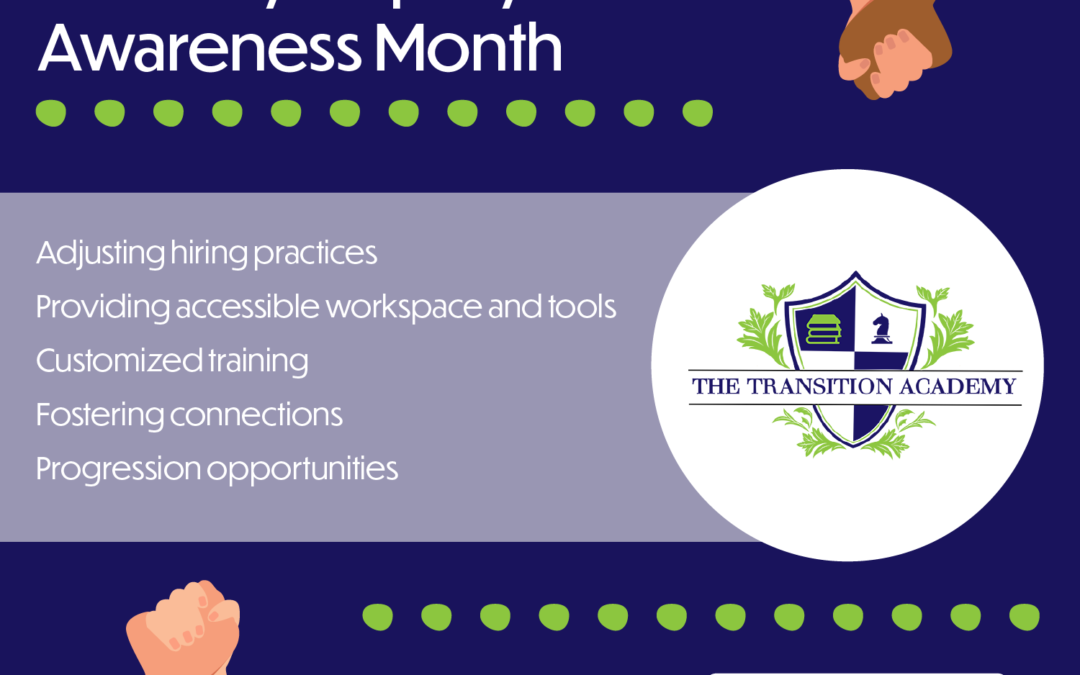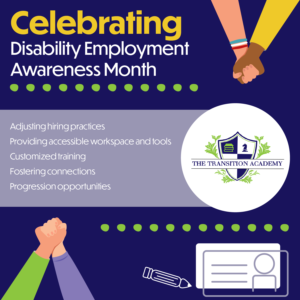Creating an Inclusive Workplace: Empowering Individuals with Intellectual and Developmental Disabilities
October is National Disability Employment Awareness Month #NDEAM, established to celebrate the significant contributions people with disabilities make to the workforce. In today’s diverse world, creating an inclusive workplace is not only a legal requirement but also a moral imperative. The Transition Academy believes inclusive workplaces will help our young people with disabilities achieve greater equity and financial independence. Right now, too many of your young people are struggling to find work, so this is an underutilized asset in our society.
THE NUMBERS
Recent reports have celebrated record-setting employment numbers of people with disabilities: 21.3% of people with disabilities had a job in 2022, up from 19.1% the previous year. However, overall employment numbers for people with disabilities are still incredibly low compared to the general population (74.4% overall employment in 2022). Additionally, employment gains have been much slower for people with disabilities who are also Black/African American. More needs to be done to provide people with disabilities opportunities to work.
EMPLOYEES WITH IDD
Employers’ conversations about inclusive workplaces often overlook the need to offer opportunities for individuals with intellectual and developmental disabilities (IDD). People with “unseen” disabilities such as ADHD, Autism, Down syndrome, learning disorders, or other cognitive delays still struggle to be fully welcomed into many workplaces. Here are some practical steps to create an inclusive workplace for people with IDD.
1. **Educate and Raise Awareness**
Ensure that all staff members understand intellectual and developmental disabilities. Ensure managers foster a culture of belonging for all employees, especially people with disabilities. Encourage open discussions and workshops to break down misconceptions and promote empathy. Consider bringing in experts or advocates who can provide valuable insights and resources.
2. **Adjust Recruitment and Hiring Practices**
Inclusivity starts with the hiring process. First, check in with yourself and your biases and consider whether your expectations need an adjustment. Not everyone will greet you with eye contact, a smile, and a handshake. Focus on skills, abilities, and potential rather than making assumptions based on appearances or preconceived notions. Offer clear and concise job descriptions, and consider using plain language to remove potential barriers. Rethink vague interview questions like “Tell me about your work experience” and rephrase to something more concrete like “What were your duties at your last job?” You may even consider trying a “working interview” where the candidate demonstrates their skills.
3. **Provide Accessible Workspaces and Tools**
Employers often consider physical accessibility, such as wheelchair access. However, organizations can also find ways to support their IDD employees with clear signage for better comprehension and quiet spaces for sensory sensitivity. Also, investing in assistive technologies or tools that support individuals with disabilities in performing their tasks has been shown to aid in improved employee morale and retention. Money well spent!
4. **Offer Customized Training and Onboarding**
Tailor training programs to meet all employees’ unique learning styles and needs, including those with IDD. Provide clear instructions, hands-on demonstrations, and written materials in accessible formats. Encourage questions and offer ongoing support throughout the onboarding process.
5. **Establish Supportive Networks**
Fostering connections between employees creates a culture of support. Consider implementing mentorship programs that pair new employees, including those with IDD, with experienced team members. Such programs can help individuals feel more comfortable, confident, and integrated into the workplace.
6. **Promote Clear Communication**
All workplaces can benefit from clear communication, but it’s especially crucial when working with individuals with IDD. Use plain language, provide clear instructions, and be patient when discussing tasks or projects.
7. **Foster a Culture of Respect and Dignity**
Regardless of ability, every employee deserves to be treated with respect and dignity. Encourage a workplace culture that values everyone’s contributions. Address any incidents of discrimination or harassment promptly, and provide clear instructions to employees for proper ways to report incidents.
8. **Flexibility and Accommodations**
Recognize that everyone has unique needs and abilities. Be flexible in accommodating different work styles and schedules. For example, some individuals with IDD may benefit from adjusted work hours or a quiet workspace. Regularly check in with employees to ensure they have the support they need to thrive. If a talented employee suddenly has performance issues, it might be time to revisit accommodations and see what supports need to be adjusted.
9. **Provide Growth Opportunities**
Any employee wants to work toward something, whether personal growth or career advancement. Offer training, upskilling, and career progression opportunities for all employees, including those with IDD. Encourage individuals to set and pursue their own goals within the organization.
BENEFITS
Creating an inclusive workplace for individuals with intellectual and developmental disabilities requires commitment, education, and a shift in mindset. Employers in the past may have expressed concern about the cost of accommodations. However, a U.S. Department of Labor report found that nearly half of all accommodations for disabled workers were low or no cost. It also found that employees offering accommodations noticed significant benefits, such as helping retain quality employees and improving overall employee morale.
Implementing these practical steps builds an environment where everyone feels valued and respected. It also empowers all employees to contribute their unique skills and perspectives, enriching the lives of employees and the organization.
The U.S. Department of Labor’s Office of Disability Employment Policy’s campaign theme for 2023 is “Advancing Access and Equity.” You can visit ODEP’s NDEAM website here to learn more.


